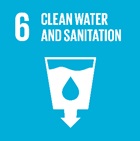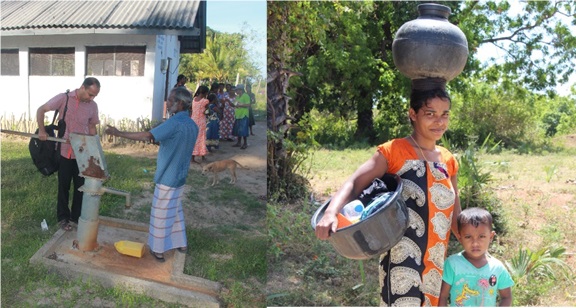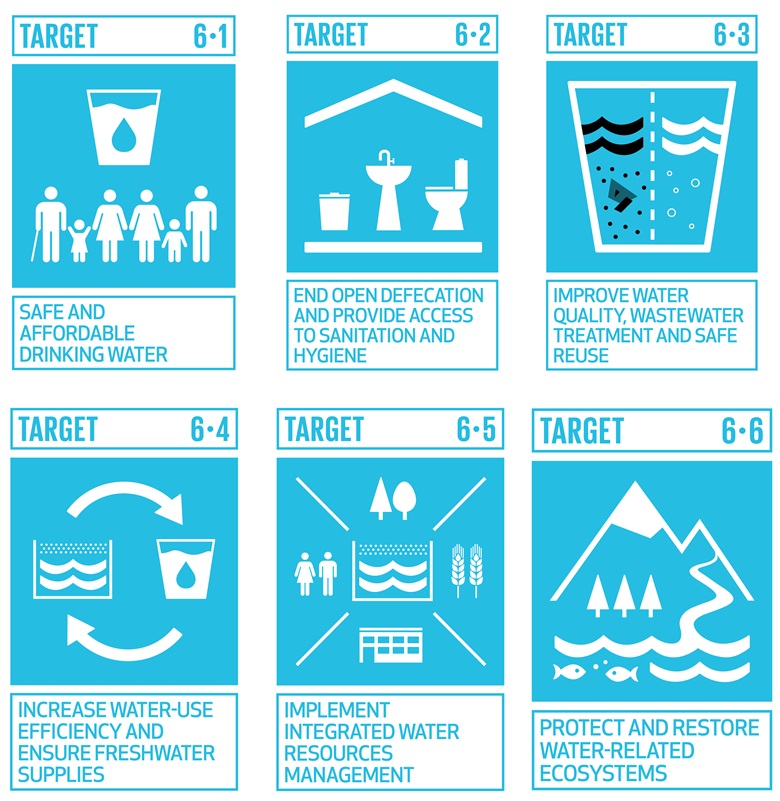Sustainable Development Goals (SDGs) – Engineers play a vital role in advancing SDG6 –‘Clean Water and Sanitation’?
By : Eng. Saja A.A. Majeed As we know, the key role of engineering is to improve the quality of life of people by developing and providing necessary community infrastructure and services. The provision of clean water and access to appropriate sanitation facilities are the key areas of community wellbeing among other essential infrastructure and services required for basic needs such as energy, food, and dwelling. However, it is alarming to note that, globally more than 300,000 children under the age of 5 years die annually due to diarrhoeal illnesses linked to lack of access to clean water and sanitation.
As we know, the key role of engineering is to improve the quality of life of people by developing and providing necessary community infrastructure and services. The provision of clean water and access to appropriate sanitation facilities are the key areas of community wellbeing among other essential infrastructure and services required for basic needs such as energy, food, and dwelling. However, it is alarming to note that, globally more than 300,000 children under the age of 5 years die annually due to diarrhoeal illnesses linked to lack of access to clean water and sanitation.
It was reported that Sri Lanka has 89% of households having access to clean water from all different types of safe water sources. It is on track to achieve its target for universal access to water by 2030, some marginalised communities still deserve access to clean water, which need urgent attention (Fan 2015). I provide an extract of an example story written by Thavarajah., N. (2018) on the dream for clean water for some people in villages in Batticaloa district, which I personally eye witnessed this tragedy during my involvement in many community projects in different parts of Batticaloa district:
“Access to water had always been a daydream to the people living in the west of Manmunai, in Batticaloa, a District in the East of Sri Lanka. For decades, the deprived and unfortunate women and children from the villages have to walk for long, along silent pathways in search of water for their household purposes. The astonishing fact here is that there are pipelines that run through these villages to distribute water to other areas. Clear water from a prominently known dam called the ‘Unichai’ flows through these lines to distribute water to other areas in the district. When the village children see water splashing out from the leaks of the pipeline, they shout in celebration and await another day to witness the same” (API, 2018). Mostly, women with the help of their children travel more than three kilometres to collect water.

Source: VDO Sri Lanka
In this context, how can Engineers contribute to attain Sustainable Development Goal (SDG) 6 – “clean water and sanitation”, which is to ensure availability and sustainable management of water and sanitation for all. In other words, we as Engineers need to ask - how can Engineers contribute to provide access to clean water and sanitation for those who have been marginalised and how can we better do it in the future. The Water, Sanitation, and Hygiene Promotion (abbreviated as WASH) is one of the key sectors in the development and humanitarian programmes of all nations. The WASH sector is linked to different key development sectors including agriculture, irrigation, power generation and many other small and medium industries, which intersect with key engineering disciplines such as civil, electrical, mechanical, and manufacturing engineering. Needless to say that WASH is one of the sectors for imperative actions by Engineers, which was recently reiterated in 2018 “The Paris Declaration: Advancing the UN Sustainable Development Goals through Engineering” by WFEO and UNESCO.
Global key figures related to ‘Clean Water and Sanitation’
According to the United Nation statistics. Some of the relevant global key figures related to clean water and sanitation include (UN Water 2017, https://www.sdg6data.org/):
- 71% of the world population use safely managed drinking water sources and 2.2 billion people still lack access to safe drinking water
- 45% of the world population use safely managed sanitation services and two billion people are without basic sanitation facilities
- 60% of the world population have access to basic hand washing facilities. In the context of COVID19 pandemic situation, hand washing has become one of the most effective ways to contain the spread of coronavirus. However, it is estimated that three billion people still lack the ability to wash their hands effectively.
- Two in five healthcare facilities worldwide have no soap and water or alcohol based hand rub (2016)
SDG 6 (Clean Water and Sanitation) targets
SDG 6 sets out six key targets and two additional targets for resource mobilisation and policy to be achieved by 2030. The eight key targets are:
6.1. By 2030, achieve universal and equitable access to safe and affordable drinking water for all
6.2. By 2030, achieve access to adequate and equitable sanitation and hygiene for all and end open defecation, paying special attention to the needs of women and girls and those in vulnerable situations
6.3. By 2030, improve water quality by reducing pollution, eliminating dumping and minimizing release of hazardous chemicals and materials, halving the proportion of untreated wastewater and substantially increasing recycling and safe reuse globally
6.4. By 2030, substantially increase water-use efficiency across all sectors and ensure sustainable withdrawals and supply of freshwater to address water scarcity and substantially reduce the number of people suffering from water scarcity
6.5. By 2030, implement integrated water resources management at all levels, including through trans-boundary cooperation as appropriate

Figure 3.1. Key targets for SDG 6
Source: https://www.globalgoals.org/
6.6 By 2020, protect and restore water-related ecosystems, including mountains, forests, wetlands, rivers, aquifers and lakes
The resource mobilisation and policy related targets are to:
6. a) By 2030, expand international cooperation and capacity-building support to developing countries in water- and sanitation-related activities and programmes, including water harvesting, desalination, water efficiency, wastewater treatment, recycling and reuse technologies
6. b) Support and strengthen the participation of local communities in improving water and sanitation management
SDG 6 (Clean Water and Sanitation) target indicators (examples)
The achievement of clean water and sanitation is measured by 11 key indicators. They are:
- Proportion of population using safely managed drinking water services
- Proportion of population using safely managed sanitation services, including a hand-washing facility with soap and water
- Proportion of wastewater safely treated and proportion of bodies of water with good ambient water quality
- Change in water-use efficiency over time and level of water stress: freshwater withdrawal as a proportion of available freshwater resources
- Degree of integrated water resources management implementation
- Change in the extent of water-related ecosystems over time
Detail indicator descriptions are available at https://unstats.un.org/sdgs website.
Current status of SDG 6 progression in Sri Lanka
The current status of achieving SDG 6 in Sri Lanka was reported in the recent review by the Government of Sri Lanka (SLVNR 2018). In this articles, the focus is on the status of WASH indicators:
- As at 2017, it was reported that 89% of the households in the Island have access to safe drinking water. This includes, protected wells within and outside dwelling premises, taps inside home or within or outside premises (main line), rural community water schemes, tube wells, water supplied through bowsers, and bottled water. The lowest coverage for accessing safe drinking water is reported in Nuwara Eliya district, which stands at 54.2%.
- 87% of the population possess onsite sanitation facilities, 9% have access to other sanitation facilities, and only 2% of the population is connected to piped sewerage.
- Major sewerage facilities are available for large urban areas such as Colombo, Ekala, Ja-ela, Moratuwa, and Ratmalana and septage treatment systems are being introduced to secondary towns such as Chilaw, Mannar, Puttalam, and Vavuniya.
Climate change adaptation measures in the water sector, for example activities undertaken to support people and farmers affected by drought, addressing the water issues in the Chronic Kidney Disease of Unknown aetiology (CKDu) prevalent areas, the expansion of pipe borne water supply coverage, and expedition of Integrated Water Resource Management (IWRM) have been identified as the priorities in the water sector that will contribute in the achievement of SDG6 targets. Similarly, extension of piped sewerage systems for municipal and urban council areas and the achievement of the 100% target for safe sanitation facilities for the people in the rural and estate sectors also need to be expedited.
Innovative examples for contributing to the achievement of SDG 6 in the engineering sector
Globally, there are many innovative community based projects in the WASH sector not only in the humanitarian setting, but also in the development context, particularly targeting rural and marginalised communities. For example, introducing new technologies for data collection, WaterAid has developed a digital monitoring platform, called ‘mWater’ (www.mwater.co) to map and monitor access to water using mobile devices, which will help to plan the water related infrastructure (RAENG 2016).
Similarly, Engineers Without Borders (EWB) in different countries such as Canada and Australia have specific innovative community based projects related to WASH sector. For example, EWB Australia (https://www.ewb.org.au/) implemented different projects providing specialist technical capacity from design, testing and maintenance of community based water and sanitation systems from portable toilets to underground rainwater tanks.
Another example is producing toy soaps to promote hygiene practices among children innovated by Field Ready (www.fieldready.org), which is a humanitarian organization working across different countries with innovative projects in a disaster setting. Although countries like Sri Lanka are advancing well in the WASH sector, there is a big scope still to promote innovation in the WASH sector to face the emerging challenges such as climate change, water pollution, public health issues, urbanisation challenges and ever increasing water related disasters.
There are many initiatives at policy, research and development, and in implementing WASH related programs, since the water sector is very wide and cut across all different disciplines. In Sri Lanka, the National Water Supply and Drainage Board also implements rural water supply schemes and the upliftment of Rural Water Supply and Sanitation of Sri Lanka through Department of Community Water Supply. Due to the limited scope of this article, which is to introduce the SDGs to young engineers and engineering graduates, only a few examples were selected from world reputed engineering related organisations.
Next SDG: SDG 7 – Affordable Energy
In the next issue of digital SLEN, we will continue with the snapshot of SDG 7: ‘Affordable Energy’. All SDGs are well connected, and thus require a holistic view to address real development challenges. Until then, let us reflect on SDG 6 – ‘Clean Water and Sanitation’ and its central role in the Engineering sector and profession. Your comments on how we as Engineers can contribute to achieve SDGs can be posted in the following IESL Facebook page https://www.facebook.com/IESLSriLanka/.
References
- https://unstats.un.org/sdgs/indicators/Global%20Indicator%20Framework%20after%202019%20refinement_Eng.pdf
- https://www.wfeo.org/wp-content/uploads/stc-young_engineers/WYEC-BROCHURE_FINAL_VERSION.pdf +
- Royal Academy of Engineering, 2016. Achieving the United Nations Sustainable Development Goals, Engineering a better world, https://www.raeng.org.uk/publications/other/engineering-a-better-world-brochure
- Sri Lanka Voluntary National Review (SLVNR) on the Status of Implementing Sustainable Development Goals, 2018. Ministry of Sustainable Development, Wildlife and Regional Development, Published by the Ministry of Sustainable Development, Wildlife and Regional Development in June, 2018.
- WFEO 2018. Engineering 2030 A Plan to advance the achievement of the UN Sustainable Development Goals through engineering , Progress Report No. 1 - October 2018 A collaborative project with Sustainable Development Goals Division of Science Policy and Capacity Building Natural Sciences Sector, http://www.wfeo.org/wp-content/uploads/un/WFEO-ENgg-Plan_final.pdf#page=16
- WFEO (2018) The Paris Declaration: Advancing the UN Sustainable Development Goals through Engineering, 7 March 2018, WFEO and UNESCO Declaration, available in Annex 1 at the https://sustainabledevelopment.un.org/content/documents/241538_World_Federation_of_Engineering_Report.pdf (Accessed on 11 November 2020).
- Nilakshy Thavarajah (2018), why don’t the waters of Unichai wet the grounds of Nediyamadhu, Asia, Women and Development, Asian Press Institute, April 13, 2018, http://www.asianpressinstitute.org/?p=1739 (Accessed on 11 November 2020).
- HAH. Jayasena, Perera, Duminda Nagabhatla, Nidhi & Vithanage, S. (2019). The Dilemma of Achieving SDG 6 Targets Under The Global Water Agenda - Analysis From Dry Zone Basins In Sri Lanka. Conference: IWA Water and Development Congress & Exhibition, Sri Lanka, December 2019.
- Mingyuan Fan, Working paper series Sri Lanka’s Water Supply and Sanitation Sector: Achievements and a Way Forward, ADB SOUTH ASIA, No. 35, June 2015.
 Eng. Saja A.A. Majeed
Eng. Saja A.A. Majeed
Lecturer
Faculty of Engineering, South Eastern University of Sri Lanka.





